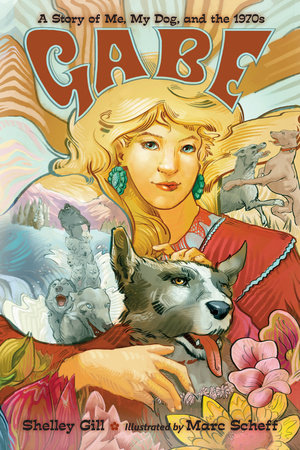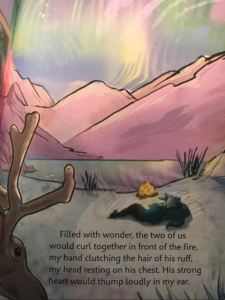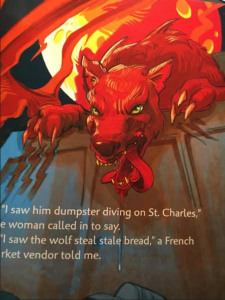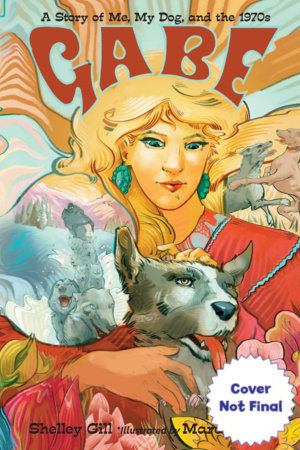 Gabe: A Story of Me, My Dog, and the 1970s
Gabe: A Story of Me, My Dog, and the 1970s
By Shelley Gill
Illustrated by Marc Scheff
Charlesbridge
$12.95
ISBN: 978-1-57091-354-9
Ages 10 and up
On shelves now
The older I get the more I like children’s books that don’t slot easily into neat little categories. Gone are the days when every book you read was easily cataloged, neat as a pin. It may be a nightmarish wasteland out there for catalogers, but the fluidity of books these days speaks to their abilities to serve different kinds of readers in different kinds of areas. Even biography sections of libraries and bookstores are morphing. I remember when Siena Siegel’s To Dance was published and we, the children’s librarians, had to come to terms with the fact that we had an honest-to-goodness children’s graphic novel autobiography on our hands (a rare beastie indeed). I’ve not really seen a book to shake up the biography sections in a similar way since. That is, until now. Gabe: A Story of Me, My Dog, and the 1970s is a textbook case of not being a textbook case. Autobiographical and deeply visual, it offers a slice of 1970s life never approached in this manner in a children’s book before. Different kinds of readers require different kinds of books to feed their little brains. This is a book for dog and pet readers, throwing them into the past headfirst and keeping them there thanks to some truly beautiful art. An original.
Growing up in Florida, Shelley Gill had enough of the vapid, polluted culture she’d grown up with. At seventeen she was out. The year was 1972 and Shelley was volunteering in the medical tent of the first Rainbow Gathering at Table Mountain. When she wasn’t patching up people she was patching up pets. And there was one pet in particular, a blue merle husky mix she named Gabe. When the party was over, Gabe was left and so Shelley kept him by her side. Together they hitchhiked, lived in New Orleans for a time, tried Colorado, suffered through NYC, were parted, reunited, and ultimately found their final home in Alaska. Gill chronicles her life through the dog that helped make that life possible. Backmatter consists of five great historical moments alluded to in the book.
 When I was growing up, the 1970s was just that decade we never quite got to in history class because we ran out of time by the end of the school year (thanks, WWII). A child of the 1980s myself, it would take me years and years and a significant chunk of my adult life to get a grasp on that time period. Children’s books that talk about the 70s or are set in the 70s aren’t exactly plentiful. Either they’re entirely about the Vietnam War or the Civil Rights movement or. . . . yeah. No. That’s about it. So Shelley Gill’s decision to place her own story inextricably within the times in which she lived is fascinating. She starts off not with Woodstock (as you might expect) but the far lesser known Rainbow Gathering of 1972. Backmatter relays information about The Vietnam War, the protests, the Civil Rights Movement, the Women’s Movement, and The Age of Aquarius. None of it is enough to serve as a focus for the story, but they do at least offer context and groundwork for kids willing to seek out additional information on their own on any of the mentioned topics.
When I was growing up, the 1970s was just that decade we never quite got to in history class because we ran out of time by the end of the school year (thanks, WWII). A child of the 1980s myself, it would take me years and years and a significant chunk of my adult life to get a grasp on that time period. Children’s books that talk about the 70s or are set in the 70s aren’t exactly plentiful. Either they’re entirely about the Vietnam War or the Civil Rights movement or. . . . yeah. No. That’s about it. So Shelley Gill’s decision to place her own story inextricably within the times in which she lived is fascinating. She starts off not with Woodstock (as you might expect) but the far lesser known Rainbow Gathering of 1972. Backmatter relays information about The Vietnam War, the protests, the Civil Rights Movement, the Women’s Movement, and The Age of Aquarius. None of it is enough to serve as a focus for the story, but they do at least offer context and groundwork for kids willing to seek out additional information on their own on any of the mentioned topics.
It’s a surprisingly slight book for the chunk of Gill’s life that it contains. That may have more to do with the author’s square focus on the dog more than anything else. Gabe is first and foremost the center of the book. Gill’s marriage, and even her eventual commitment to dog sledding, pale in the face of this owner/pet love story. In 2011 Adam Gopnik wrote a piece for The New Yorker called “Dog Story” in which he talked about pet owners’ blind adoration of their own dogs. It’s a fun piece because, amongst other things, it really clarified for me the fact that I am just not a dog person. If you have a friendly dog I’ll pet it like crazy and enjoy its company, but other people’s dogs are like other people’s children. You appreciate their existence on this globe (hopefully) but wouldn’t necessarily want one of your own. The interesting thing about Gabe is that Gill makes no bones about his bad qualities. She loves him, psychopathic tendencies and all. He is her constant companion through thick and thin and (craziest of all) the 1970s. I don’t feel particularly gushy towards dogs, but a good writer allows you to feel emotions that aren’t your own. And in that last page, where Shelley cuddles her dying dog? That, I felt.
 The text is great, no question, but would be merely okay with a lesser illustrator. So a lot of the heavy lifting going on in this title is due the talents of Marc Scheff. I would love to hear the story of how Marc came to this particular book. A quick look at his various websites and you can see that he describes himself as the kind of artist who creates, “portraits that blend the fantastic and the surreal.” In Gabe Scheff scales back his more sumptuous tendencies, but not by much. He’s sticking to reality for the most part, but there’s one moment, when people are exchanging rumors of an escaped devil dog terrorizing the citizens of New Orleans, where he allows the paper he paints to gorge itself in a blood red beast awash in snarls and drool. Shelley herself is the kind of woman Scheff typically likes to paint. A 20th century Rossetti model, all flowing hair and latent hippie tendencies. Farrah Fawcet would have been envious. And Gabe is consistently fascinating to watch throughout. Scheff’s challenge was to make him tame enough that a girl would do anything to keep him by her side, but also wild enough to attack at a moment’s notice. For the book to work you have to like Gabe on some level. That may be the most difficult challenge of the book, but Scheff is up to the task and the end result is a dog that, at the very least, you respect on some level.
The text is great, no question, but would be merely okay with a lesser illustrator. So a lot of the heavy lifting going on in this title is due the talents of Marc Scheff. I would love to hear the story of how Marc came to this particular book. A quick look at his various websites and you can see that he describes himself as the kind of artist who creates, “portraits that blend the fantastic and the surreal.” In Gabe Scheff scales back his more sumptuous tendencies, but not by much. He’s sticking to reality for the most part, but there’s one moment, when people are exchanging rumors of an escaped devil dog terrorizing the citizens of New Orleans, where he allows the paper he paints to gorge itself in a blood red beast awash in snarls and drool. Shelley herself is the kind of woman Scheff typically likes to paint. A 20th century Rossetti model, all flowing hair and latent hippie tendencies. Farrah Fawcet would have been envious. And Gabe is consistently fascinating to watch throughout. Scheff’s challenge was to make him tame enough that a girl would do anything to keep him by her side, but also wild enough to attack at a moment’s notice. For the book to work you have to like Gabe on some level. That may be the most difficult challenge of the book, but Scheff is up to the task and the end result is a dog that, at the very least, you respect on some level.
For all that I love the art of the book, there is one element of the design I’d change in a heartbeat, if I had that power. That would be (and this is going to sound crazy to you if you haven’t seen the book yet) the size of the font on each new chapter’s first page. Somebody somewhere made the executive decision to shrink that font down to teeny, tiny, itty-bitty, oh-so-miniscule words. In some chapters this is clearly done to fit a large amount of text into a particular part of the accompanying illustrations. The trouble is that it just looks awful. Right from the bat it sets the wrong tone for everything. It was with great relief that I turned the first page to discover a far larger, lovelier font for most of the rest of the book. Yet with every new chapter there it would be again. That small, horrid little font. A weird complaint, you bet, but for a book that relies so heavily on attractive visuals, this seems an unfortunate misstep.
The more graphic and visual a children’s book, the more opportunities to really put the reader in a historical time and place. For the 9-year-old that picks up and reads this book, the 1970s might as well be the 1670s. Yet together Gill and Scheff transport their young readers. From the sweltering heat of New Orleans to the dry chill under an Aurora Borealis, you are there. Gill writes what she knows and what she knows is the story of her best dog. A moving, eye-popping, ambitious, genre-busting little number. I guarantee you this – you’ll find nothing else like it on your bookshelves today.
On shelves now.
Source: Final copy sent from publisher for review.
Like This? Then Try:
- To Dance by Siena Siegel, illustrated by Mark Siegel
- Little White Duck by Na Liu
- Laika by Nick Abadzis
Professional Reviews:
Websites:
Alternate Cover Art:
Apparently this was the original cover. Had I seen it first, I probably wouldn’t have minded those eyes, but now? So glad they changed ’em. It looks like she’s mere moments away from taking a big ole bite of doggie.







As someone born in 1975, who barely remembers the 70s, I still get a kick out of books set then, especially in NYC. I could swear I read two recently but can only think of the title of one: Burn Baby Burn by Meg Medina. It’s YA and I know your feelings on that but still – I highly recommend it. And if anyone has a guess as to what the other book might have been, please, put me out of my misery.
What is a Rosetti model? I had not heard the term before. Just did a google search and I am still not sure what you are trying to say?
Paintings by Dante Gabriel Rossetti. I just think the models in those paintings bear a bit of a resemblance to what Scheff is doing here. Flowing hair n’ such.
Indulge this long comment:) As someone who was a teen at the time of this book I have to gently disagree with your statement that she is “A 20th century Rossetti model, all flowing hair and latent hippie tendencies. Farrah Fawcet would have been envious.” First of all, she isn’t latent — she IS a hippie in this book:) The Rainbow Gathering — I remember hearing about it and many others of its ilk. Her wanderings are spot-on for a particular sort of hippie. Hitch hiking, etc — all absolutely what as done. (The summer of 1971 I went to Europe with two women who absolutely insisted we hitched because it was cool not because we needed to. I actually hated it and we struggled to get rides as we were three with enormous backpacks.) As for the images, they are absolutely of the time — and I would guess that she would be horrified to be connected in any way to Farrah Fawcet. Those of us who identified as hippies were completely and utterly dismissive of Fawcet and her ilk. What the images remind me of more are those of album covers of the time, especially those by Peter Max. Lastly, regarding Rosetti, a self-indulgent anecdote. I remember sitting in the Cloisters’ garden (Met Museum’s medieval wing in northern Manhattan), studying and my long flowing auburn hair and dress caused someone to tell me I looked like a Rossetti. Went back to the library to see what those looked out and have been proud ever since.
I take back that she would be horrified about Farrah Fawcet. I would have been, but can’t speak for her:)